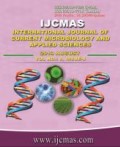


 National Academy of Agricultural Sciences (NAAS)
National Academy of Agricultural Sciences (NAAS)

|
PRINT ISSN : 2319-7692
Online ISSN : 2319-7706 Issues : 12 per year Publisher : Excellent Publishers Email : editorijcmas@gmail.com / submit@ijcmas.com Editor-in-chief: Dr.M.Prakash Index Copernicus ICV 2018: 95.39 NAAS RATING 2020: 5.38 |
During various Capripox outbreaks in Jammu region, either sheep or goats were found to be affected separately by the disease showing the characteristic cutaneous lesions. Even when both sheep and goats were reared together, the disease was restricted to either host only. Clinical scab samples obtained from both sheep and goats were designated as putative Sheep poxvirus (SPPV) and Goatpoxvirus (GTPV). The isolates were processed and inoculated on the chorioallantoic membrane (CAM) of chicken embryonated eggs (CEE) to study the growth characteristics of the isolates. While sheep isolates failed to grow on chorioallantoic membrane (CAM) of chicken embryonated eggs (CEE), goat isolates showed haemorrhages and thickening of membrane with presence of white pock lesions after 2-3 serial passages. Histological examination of the affected CAM showed degeneration of the ectodermal layer together with vacoulation of cells. There were areas of necrosis and presence of eosinophilic intracytoplasmic inclusion bodies within the stromal cells. The putative isolates were confirmed as belonging to SPPV and GTPV genotypes after nucleotide sequencing of partial P32 core protein gene. It is assumed that the differential growth characteristics of the isolates may be an indication of strain variability. Further it is inferred that the non-ability to grow in CEE cannot be used as a criterion either to negate the diagnosis of CaPV, nor the differentiation between SPPV and GTPV.
 |
 |
 |
 |
 |